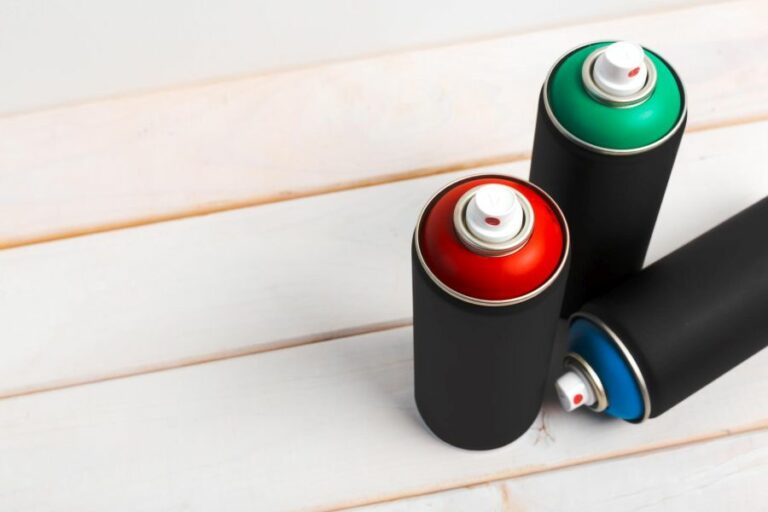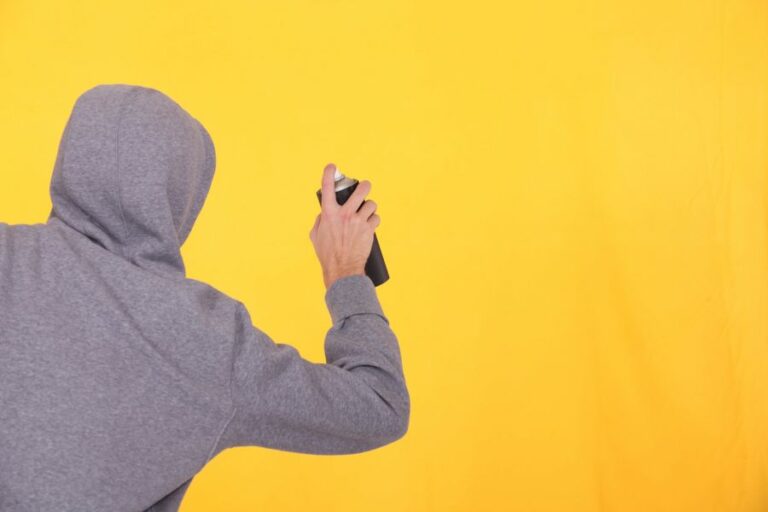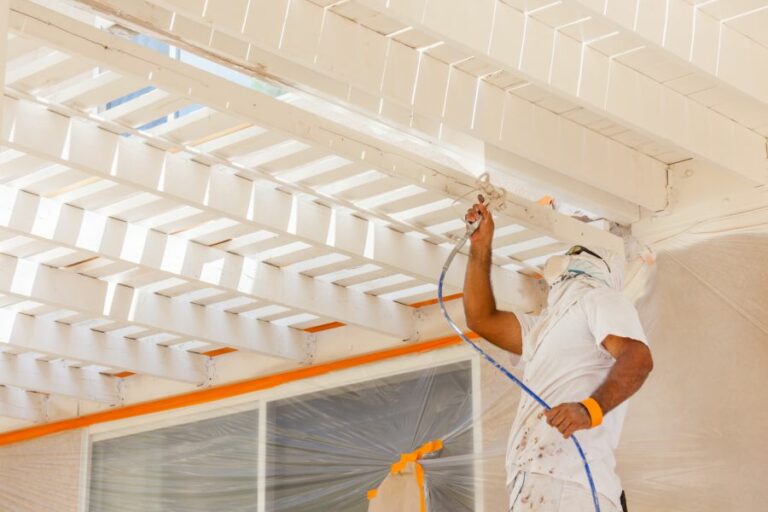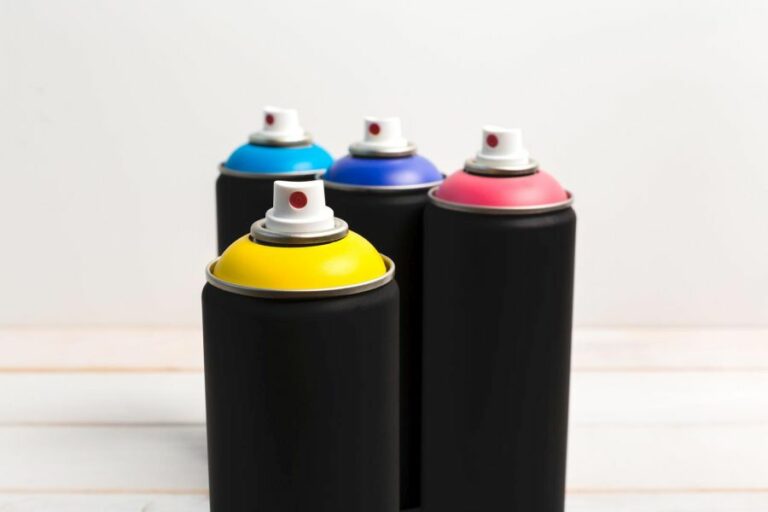Spray Painting Tips: Keeping Your Art Lasting Longer
Spray painting is an incredible art form that allows creativity to flow with every pass of the can. But it can be quite disheartening when your masterpiece begins to fade or chip too soon. Worry not, fellow artists! We’re here to guide you through essential tips and tricks to ensure your spray paint creations withstand the test of time.
Spray painting tips: keeping your art lasting longer:
To create lasting spray paint art, choose the right surface and prepare it with proper primers (e.g., wood, metal, or plastic primer). Invest in high-quality, weather-resistant paints from reputable brands. Employ expert techniques like shaking the can, maintaining proper distance, and overlapping strokes. Finally, protect your artwork with a suitable varnish or clear coat.

Continue reading to discover essential spray painting tips that will help you create durable and long-lasting artwork. From preparation to aftercare, we’ve got you covered. Unlock the secrets to protecting your masterpieces for years to come. Read on!
Contents
- 1 Prolonging Your Spray Paint Art: Essential Techniques
- 2 Enhancing Spray Paint Durability: Expert Strategies
- 3 Unlocking the Ultimate Spray Painting Secrets
- 4 Achieving Optimal Results in Spray Paint Projects
- 5 Safeguarding Your Spray Paint Creations: Top Tips
Prolonging Your Spray Paint Art: Essential Techniques
Spray painting is a popular and versatile medium that is favored by artists, DIY enthusiasts, and professionals alike.
Whether you’re painting street art, upcycling furniture, or creating signs, achieving a professional finish that stands the test of time is essential. Here are some tips from my experience to help you create artwork that lasts.
• Choose the Right Surface and Prepare It
Before you begin, choosing a suitable surface is crucial. Ideally, you should work on surfaces that are smooth, clean, and free of grease or dust. Properly preparing the surface can significantly impact the longevity of your artwork.
- Wood: As wood is porous, applying a primer can help the paint adhere better and prevent color absorption. Sand the wood lightly for optimal results before applying a primer.
- Metal: Use a metal primer to prevent rust and improve adhesion. Painting on non-galvanized metal may also improve paint durability. Before applying a primer, clean and sand the surface to remove any possible contaminants.
- Plastic: Primer is also necessary when working with plastic, but make sure to use a plastic primer specifically designed for the task. Sanding the surface with fine-grit sandpaper can eliminate gloss and help the primer adhere better.
• Select the Right Paint
When it comes to spray paints, not all are created equal. Take the time to research different brands and paint types to ensure you’re using the best product for the job.
Quality matters when it comes to longevity, so it’s worth investing in high-quality spray paint from reputable brands like Montana, Krylon, or Rust-Oleum.
In addition, consider the following factors when selecting your paint:
- Finish: Matte, satin, or glossy finishes can impact durability. Glossy paint, for example, can be more resistant to fading and wear compared to matte finishes.
- Environment: Consider where your artwork will be displayed. If it is exposed to harsh weather conditions, opt for a paint that offers UV resistance and protection from the elements.
- Compatibility: Ensure the paint is compatible with your chosen surface and any primers, varnishes, or other products used in your project.
• Learn the Techniques
While spray painting may seem simple, there are several expert techniques and tips you should follow to achieve a professional finish:
- Shake properly: Shake the can vigorously for a minute to mix the paint and ensure even pressure during application.
- Test first: Before painting your final piece, practice on scrap material to test the pressure, color, and texture.
- Distance: Maintain a consistent distance from the surface, typically about 6-12 inches, to achieve even coverage and avoid drips or blotches.
- Movement: For a smooth finish, use swift, sweeping motions as you apply the paint. Start and finish your stroke before and after the object, respectively.
- Overlap: Make sure to overlap each pass slightly to ensure even coverage and avoid stripes or inconsistencies.
• Protect Your Artwork
Lastly, don’t forget to seal and protect your work with a suitable varnish or clear coat. A good quality clear coat can offer UV protection, water resistance, and even anti-graffiti properties. Choose a product that is compatible with your paint and surface, and apply it according to the manufacturer’s instructions.
- Ventilation: Apply varnish in a well-ventilated area to ensure proper drying and curing.
- Timing: Allow enough curing time for the paint before applying the varnish. Follow the guidelines provided by the paint manufacturer.
- Test: Just like with your paint, test the varnish on a small, inconspicuous area or a scrap piece to ensure compatibility and avoid any surprises.
By following these tips and taking the necessary precautions, you’ll be well on your way to creating beautiful, lasting artwork. Remember that practice makes perfect, so don’t be afraid to learn from your mistakes and refine your skills. With time and patience, your art will be standing the test of time.
Enhancing Spray Paint Durability: Expert Strategies
Spray paint is an incredibly versatile and valuable tool in day-to-day DIY projects, artwork, or professional applications. However, spray paint can have a short lifespan if not adequately taken care of or used correctly.
• Proper Surface Preparation
Before beginning any spray paint project, it is crucial to thoroughly prepare the surface. This initial step will significantly impact the paint’s longevity.
- Clean the surface: Cleaning is essential to remove any dirt, dust, or grease that can affect the paint’s adherence to the surface. Using an appropriate cleaner such as TSP (trisodium phosphate) or a mild detergent followed by a thorough rinse with water is highly recommended.
- Sanding: For surfaces in need of smoothing, lightly sand the area using 180-220 grit sandpaper. Sanding enhances the paint’s adherence by creating a rough surface for the paint to bond to.
- Prime the surface: Applying a suitable primer will help the paint stick better and last longer. Choose a primer that is specifically designed for your project’s material (e.g., metal, plastic, or wood) and spray paint type (e.g., oil or water-based).
• Choose High-Quality Spray Paint
Investing in high-quality spray paint is essential for long-lasting results. Superior paint often has better pigmentation, adhesion properties, and a more durable finish. Look for reputable brands and choose the spray paint type that is compatible with your surface and project requirements.
• Proper Spray Paint Techniques
Using the correct spray paint techniques will not only ensure a smooth and even finish, but it will also help to extend the paint’s lifespan.
- Shake the can well: Before starting to paint, shake the can for at least one minute, and occasionally during use, to mix the paint thoroughly and maintain consistent pressure.
- Test spray: To avoid drips, splatters, or uneven coverage, perform a test spray on a piece of cardboard, adjusting your spray technique as needed.
- Maintain proper distance: The ideal distance to hold the spray can is approximately 8-12 inches from the surface. This distance ensures an even distribution of paint and prevents drips or uneven coverage.
- Apply thin, even coats: To achieve a smooth finish and allow the paint to bond better, apply several thin, even coats instead of a single thick coat. Allow each coat to dry according to the manufacturer’s recommendations before applying the next coat.
• Optimal Environmental Conditions
Spray painting under the right environmental conditions is critical for the paint’s longevity.
- Temperature: The optimal temperature for spray painting is between 50-90°F (10-32°C). Extreme temperatures can cause the paint to dry too fast or too slow, resulting in a poor-quality finish.
- Humidity: Low to moderate humidity (40-60%) is ideal for spray painting. High humidity can prolong drying time and cause defects in the paint film.
- Avoid direct sunlight: Painting in direct sunlight can cause the paint to dry too quickly, leading to a rough or uneven finish.
• Proper Curing and Drying Time
Allowing the paint to cure and dry correctly is essential for durability. Some factors to consider include:
- Follow the manufacturer’s recommended drying times between coats.
- Prepare your project for curing by ensuring the area is clean, dry, and well-ventilated to allow the paint to harden fully before handling.
- Check the paint can for the recommended curing time, and avoid handling or using the project during this time.
• Protective Finishing
For added durability and protection against the elements, consider applying a protective coat to ensure the spray paint lasts longer. Clear coats or sealers can help protect the paint from fading, chipping, or peeling. Choose a finish that is compatible with your spray paint type.
• Proper Storage
If you have a partially used can of spray paint, store it correctly to prolong its shelf life. Following these tips for proper storage:
- Store your cans in a cool, dry place, away from direct sunlight or heat sources.
- Keep the cans upright to prevent the nozzle from clogging.
- Before storing, clean the nozzle by holding the can upside down and spraying until only clear gas emanates from the nozzle.
In conclusion, taking the time to prepare surfaces adequately, using high-quality paint, applying proper techniques, and paying attention to environmental conditions will go a long way in making your spray paint last longer.
With the right approach and knowledge, your spray paint projects will be both beautiful and durable, ensuring a lasting impact on your work.
Step | Description |
|---|---|
1. Clean the surface | Wash the surface thoroughly, removing dirt, grime, and dust to ensure proper paint adhesion. |
2. Sand the surface | Smooth the surface with sandpaper to create a better surface for the paint to stick to. |
3. Prime the surface | Apply a primer to the surface before spray painting for better adhesion and coverage. |
4. Shake the spray paint can | Shake the can for at least a minute to ensure proper mixing of the paint and chemicals. |
5. Apply thin coats | Use several thin coats of paint rather than a single thick coat for better durability and a smoother finish. |
6. Apply the paint in a controlled environment | Paint in an area with minimal dust, wind, and humidity for better adhesion and drying process. |
7. Allow proper drying time | Allow each coat to dry completely before applying the next coat to ensure durability and prevent chipping. |
8. Seal and protect the paint | Apply a clear coat or sealant to protect the paint from scratches, chipping, and fading. |
9. Store spray paint properly | Keep the spray paint can in a cool and dry place to prolong its shelf life and maintain its performance. |
Unlocking the Ultimate Spray Painting Secrets
Spray painting is an efficient and cost-effective way to transform a wide range of surfaces, from automotive parts and furniture to walls and home decor items. But what is the secret to achieving professional and flawless spray painting results?
• The Importance of Surface Preparation
Before diving into the actual painting process, it’s crucial to properly prepare the surface of the object you plan to paint. A clean, smooth surface will provide the ideal foundation for the spray paint to bond.
– Clearing Dirt and Debris
Start by giving the surface a thorough cleaning to remove any dirt, dust, and grease. For metal items, a degreaser like acetone or denatured alcohol can be used. For plastic and other non-metal surfaces, a mild detergent and water solution should suffice.
Ensure the surface is completely clean and dry before moving on to the next step.
– Sanding for a Smooth Finish
To achieve a refined, even surface, sanding is key. Start by sanding the surface with 180- to 220-grit sandpaper, making sure to remove any existing paint or rust. After the initial sanding, use a finer 320- to 400-grit sandpaper for a smooth finish.
For curved or detailed areas, manually sand with either a sanding block or a flexible sanding sponge.
– Masking: Protect your Non-Painted Areas
Mask off any areas on the object you don’t want to paint. This can be done using painter’s tape and/or plastic sheeting. You may also need to cover nearby areas to prevent overspray.
• Choose the Right Spray Paint and Equipment
Selecting the right spray paint and equipment is essential to yielding professional results. Here are some factors to consider:
– Quality Spray Paint
Using high-quality spray paint will ensure optimal coverage, durability, and finished appearance Carcaretotal. Look for a paint that is specifically designed for the material you are painting (e.g., metal, wood, plastic).
In some cases, investing in a primer is necessary to enhance adhesion and cover any imperfections.
– Proper Application Equipment
Using the correct nozzle for your spray paint can make a significant difference in the consistency and finish of your application. Some spray paint cans come with adjustable nozzles, while others may require purchasing a separate nozzle accessory.
Additionally, consider using a spray paint handle for a more controlled and comfortable grip.
• Mastering Spray Painting Techniques
– Proper Environment
To achieve a flawless spray paint finish, always work in a well-ventilated area that is free of dust and debris. This helps to eliminate particles from becoming trapped in the wet paint.
Additionally, avoid painting in direct sunlight or high humidity, as this can cause paint to dry too quickly, leading to an uneven finish.
– Shake Well
Prior to beginning your project, ensure your spray paint can is thoroughly mixed by shaking it vigorously for at least one minute. This will guarantee the paint is evenly dispersed within the can, leading to consistent color and coverage.
– Start With a Test Run
Before applying paint to your project’s surface, conduct a test run on a scrap piece of material or cardboard. This will help you gauge paint consistency, test the spray nozzle, and fine-tune your technique.
– Maintain a Consistent Distance
When spraying, maintain a consistent distance of 8 to 12 inches from the surface. This allows for an even coating of paint and prevents paint buildup or drips.
– Spray with Fluid, Overlapping Strokes
For professional results, apply paint using fluid, horizontal and vertical strokes while overlapping each stroke by about one-third to one-half. This will create a uniform finish without streaks or “tiger striping” patterns.
– Multiple Light Coats versus One Heavy Coat
When spray painting, it’s essential to apply multiple light coats instead of one heavy coat, allowing each coat to dry per the manufacturer’s recommended drying time. Applying a single heavy coat can cause paint to sag, run, or become uneven upon drying.
• Properly Caring for your Spray Painted Items
Once your project is complete and the paint is fully cured, invest in quality protective wax or clear coat for added durability and shine; this is especially important for outdoor items. Regular cleaning with a mild, non-abrasive cleaner will also help maintain the finish.
• Conclusion
The secret to spray painting lies in proper surface preparation, choosing the right equipment, and mastering your application technique. Follow these tips, and you’ll achieve professional, flawless spray painting results, whether you’re a DIY enthusiast or a seasoned pro.
Achieving Optimal Results in Spray Paint Projects
Spray painting can be a quick and effective way to revitalize surfaces, whether you’re renovating furniture or adding a pop of color to your living space.
However, achieving professional-quality results with spray paint can prove challenging for some, especially if you’re not familiar with the process. With the right techniques, tools, and planning, you can effortlessly achieve a smooth, even finish that rivals the work of professionals.
• Selecting the Right Spray Paint
Your choice of spray paint plays a crucial role in determining the final finish. Not all spray paints are created equal, and selecting the wrong one can lead to disappointing and underwhelming results.
– Quick-Dry Spray Paints
As the name suggests, these paints dry rapidly upon application. They’re perfect for projects with tight deadlines or when working in less-than-ideal conditions, such as high humidity or low temperatures.
Quick-dry spray paints reduce the risk of dirt, dust, or other particles becoming trapped in the paint, resulting in a smoother finish. Rust-Oleum is a popular brand that offers a wide selection of quick-dry spray paints.
– Enamel Spray Paints
These paints are known for their durability and resistance to the elements. They create a hard, glossy finish that stands up well to wear and tear, making them ideal for outdoor projects or surfaces that undergo heavy use.
Enamel spray paints can take longer to dry than other types, but the wait is often worth it for their long-lasting results.
– Paint and Primer in One
Some spray paints come with a built-in primer. This can be a time-saving option, as it eliminates the need to prime your surface beforehand. However, using a separate primer is recommended if your project requires a specific primer or if you’re painting over a darker color.
• Preparing the Surface
Proper surface preparation is essential for ensuring the best possible finish when spray painting. The key to success is taking the time to clean, sand, and prime (if necessary) before applying paint.
– Cleaning
Thoroughly clean the surface with a solution of soap and water or a commercially-available cleaning product. This removes dirt, grease, and grime, which can prevent the paint from adhering to the surface or lead to an uneven finish. Allow the surface to dry completely before moving on to the next step.
– Sanding
Sanding is crucial for a smooth final result. Use fine-grit sandpaper (180-220 grit) to roughen the surface slightly, creating a texture that helps the paint bond more effectively. After sanding, wipe away the resulting dust with a tack cloth or damp cloth, ensuring the surface is entirely clean.
– Priming
If you’re not using a paint-and-primer combination, apply a suitable primer for your surface (such as wood, metal, or plastic) using the same technique as for spray painting (described below). Primers create a base layer that improves paint adhesion, making it less likely to chip, peel, or flake in the future.
• Proper Spray Painting Technique
Once your surface is prepared, it’s time to apply the spray paint. Proper technique is crucial for preventing drips, sags, or uneven coverage.
– Shaking
Shake the spray paint can vigorously before use, as directed by the manufacturer. This mixes the paint and propellant, ensuring a consistent spray pattern and even color distribution.
– Testing
It’s always a good idea to test your spray paint on a scrap piece of material before applying it to your project. This allows you to gauge the color, coverage, and spray pattern, making any necessary adjustments before moving on to your actual workpiece.
– Spraying
Hold the can approximately 10-12 inches away from the surface you’re painting. Ensure that it’s at an even distance as you spray, moving steadily across the surface in a horizontal or vertical motion.
Apply light, even coats, and avoid the temptation to “flood” the area with paint, as this can lead to drips and sags.
Between coats, allow the paint to dry according to the manufacturer’s instructions. This ensures that each layer bonds effectively, creating a smooth and durable finish. Applying multiple thin coats is generally preferable to fewer thick ones.
• Finishing Touches and Clean-up
After completing your spray painting work, it’s crucial to clean up properly and add any necessary finishing touches.
– Sealing
In some cases, such as outdoor projects or heavily-used items, applying a clear sealer can provide additional protection and longevity for your paint job. Ensure the paint is fully dry before applying any sealers.
– Reassembling
If you’ve disassembled any items (such as furniture) for painting, wait until everything is completely dry before reassembling. This avoids damaging the paint finish.
– Cleaning
For reusable spray equipment (such as airbrushes or spray guns), it’s essential to clean them thoroughly after use. Follow the manufacturer’s instructions for cleaning and maintenance, ensuring that all paint residue is removed.
Spray painting can provide exceptional results when done correctly. With the right tools, techniques, and preparation, you can achieve a professional finish that adds new life to surfaces and items throughout your home or workspace.
Steps | Description |
|---|---|
1. Choose the right environment | Avoid windy or wet conditions, and make sure the area is well-ventilated. |
2. Prepare the surface | Clean the surface and remove any loose or peeling paint, rust, or dirt. Be sure to sand and smooth the area if needed. |
3. Use a primer | Apply a suitable primer to ensure better adhesion of paint and an even finish. |
4. Shake the spray paint can | Shake the can for at least a minute to mix the paint well. |
5. Test the spray paint | Practice spraying on a scrap piece of material to ensure proper flow and technique. |
6. Apply thin and even coats | Hold the can about 8-12 inches from the surface, making sure to maintain a consistent distance to avoid drips and runs. |
7. Allow time to dry | Allow each coat to dry thoroughly before applying the next one. |
8. Protect the finish | Consider applying a clear top coat for added protection and durability. |
Safeguarding Your Spray Paint Creations: Top Tips
Spray paint art is an incredible and versatile form of artistic expression that creates beautiful pieces with vibrant, intense colors. However, it can be susceptible to damage over time if not properly protected. This guide will outline the essential steps and best practices for preserving your spray paint artwork, ensuring it remains as stunning as the day you created it.
• Choosing the Right Spray Paint
One of the first steps to ensuring your artwork lasts is selecting the right type of spray paint. Investing in high-quality paint that is designed for long-term durability is key.
– Recommendations:
- Use a paint that is labeled for use on multiple surfaces, like the Montana Cans line.
- Opt for a paint that is UV-resistant to avoid color fading over time.
- Consider using acrylic-based spray paint, as it is more resistant to environmental factors than other types.
• Surface Preparation
Preparing your art surface is crucial to the longevity of your spray paint art. The surface should be clean, dry, and properly primed for the paint to adhere effectively.
– Recommendations:
- Clean the surface thoroughly with a mixture of warm water and dish soap.
- Dry the surface completely with a clean cloth.
- Prime your surface with a suitable primer (e.g., Gesso primer for canvas).
• The Importance of Clear Coating
Applying a clear coat over your spray paint art is essential for protection. It will help to create a barrier against UV rays, moisture, and oxidation, which can lead to color fading or discoloration.
– Recommendations:
- Choose a high-quality clear coat designed for use with spray paint (e.g., Krylon Clear Coat).
- Apply multiple layers of clear coat, allowing each layer to dry fully before applying the next.
- Ensure clear coat covers the entire piece, including the edges, for maximum protection.
• Proper Drying and Curing
Allowing your spray paint art to dry and cure properly is crucial before applying any protective measures. Most spray paint types require different amounts of time to dry and cure.
– Recommendations:
- Allow at least 24-48 hours for the paint to dry before attempting to clear coat.
- Cure times for spray paint can range from one week to one month. Check the label on your specific paint type to see the recommended curing time.
• Storage and Display
Where and how you display your spray paint art can greatly impact its longevity. Keep in mind the following factors when selecting a location for your piece:
– Recommendations:
- Avoid displaying your artwork in direct sunlight, as this can cause colors to fade.
- Maintain a consistent temperature and humidity level in the area where your art is displayed. A hygrometer can help you monitor humidity levels.
- If storing your spray paint art, use acid-free materials to wrap or cover, and store it in a climate-controlled environment.
• Regular Maintenance
Keep your spray paint art looking its best by performing regular maintenance checks. By doing regular check-ups, you can identify and address any issues before they escalate.
– Recommendations:
- Check for dust build-up and gently clean with a soft brush.
- Examine your artwork for any signs of color fading, and if necessary, apply an additional layer of clear coat protection.
• Repair and Restoration
In the event that your spray paint art does suffer damage or deterioration, it’s essential to address the issue promptly to prevent further problems.
– Recommendations:
- Consult a professional conservator for advice on the best course of action.
- Attempt any repairs yourself only if you have the necessary skills and experience.
• Additional Resources
For further information on protecting your spray paint art or spray paint techniques and best practices, the following non-commercial websites offer valuable insights and tips:
In conclusion, protecting your spray paint art involves selecting high-quality materials, proper surface preparation, clear coating, drying and curing, storage and display, maintenance, and timely repair. By following the recommendations and best practices in this comprehensive guide, you can ensure your spray paint art remains vibrant and well-preserved for years to come.
Step | Description |
|---|---|
1 | Let the spray paint dry completely |
2 | Choose a clear coat or sealant appropriate for the surface you’re working on |
3 | Make sure the area is well-ventilated and free of dust or debris |
4 | Apply the clear coat or sealant evenly, following the manufacturer’s instructions |
5 | Allow the clear coat or sealant to dry completely before touching or displaying the artwork |
6 | Store or display the artwork in a protected area, away from direct sunlight and harsh elements |







